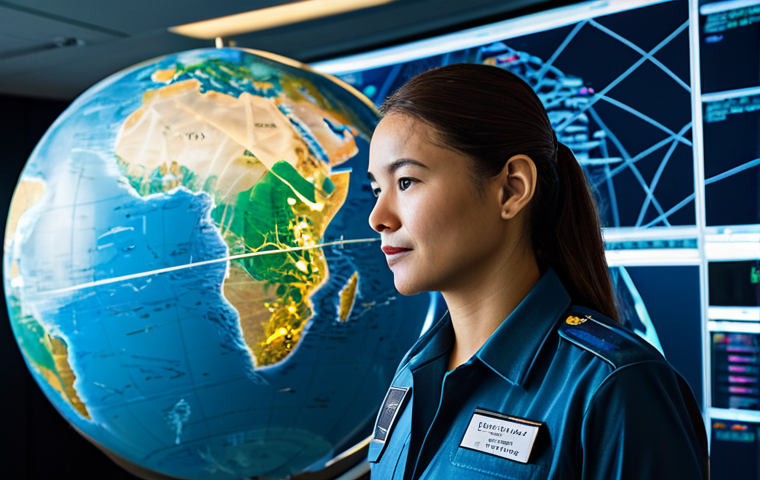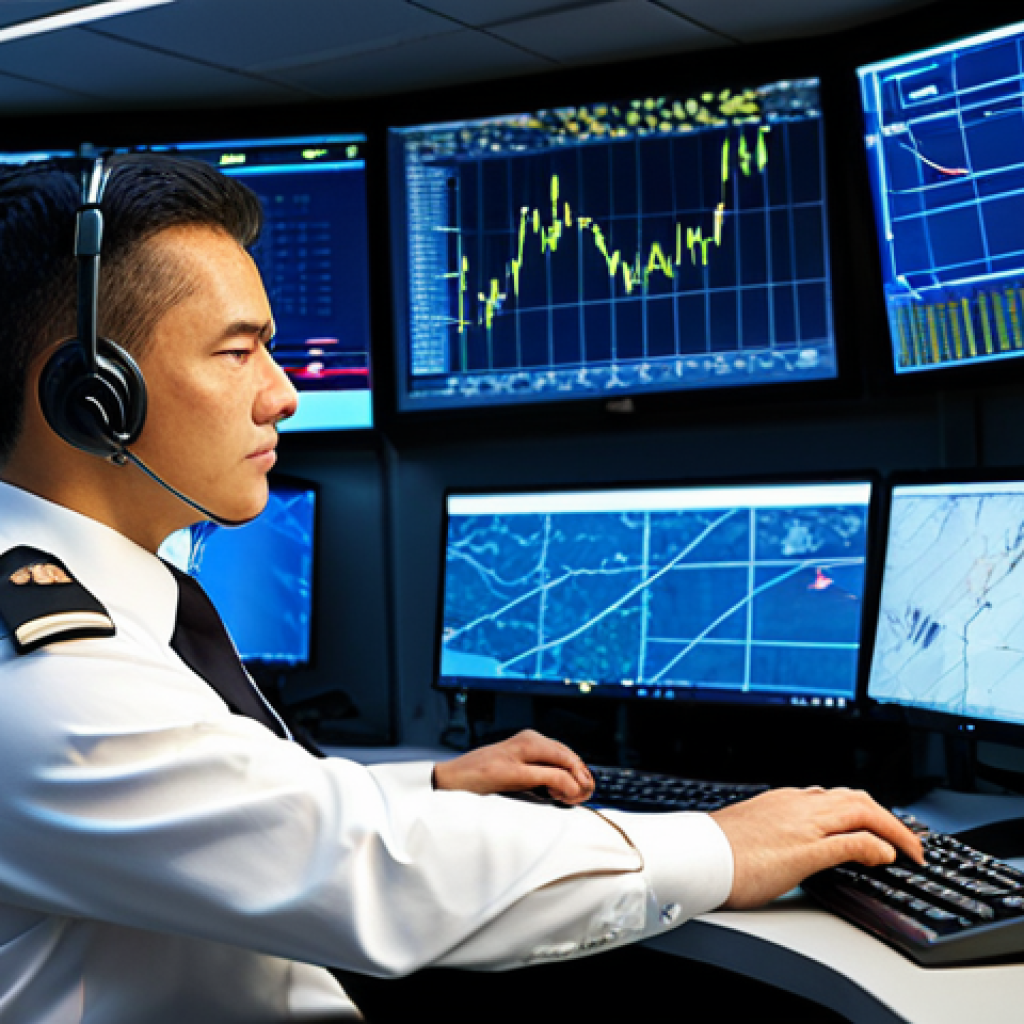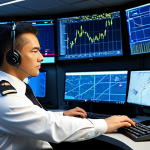Ever wondered about the hidden heroes making your flights smooth and safe? While pilots often get the glory, there’s an equally vital role working tirelessly behind the scenes: the Flight Operations Officer, or FOO.
From meticulously planning routes to constantly monitoring real-time weather and even global events, their expertise is the bedrock of every successful journey.
But here’s the kicker – in our increasingly interconnected world, their job isn’t just about managing flights within national borders; it’s deeply intertwined with complex international cooperation.
It’s a fascinating world where precision meets diplomacy, and I’ve seen firsthand how crucial this synergy truly is. Think about it: an aircraft often crosses multiple airspaces, each governed by different regulations and air traffic control centers.
This isn’t just about handing over a flight; it requires seamless, instant communication and strict adherence to globally recognized standards set by bodies like ICAO.
From my perspective, the rise of AI-driven predictive analytics is a game-changer, allowing FOOs to anticipate weather shifts or airspace closures with unprecedented accuracy, but it still demands their seasoned human judgment to interpret and act.
Future challenges, like integrating burgeoning Urban Air Mobility (UAM) into already congested skies or navigating unexpected geopolitical tensions that can suddenly render vast swaths of airspace off-limits, underscore the absolute necessity of robust, real-time international collaboration.
It’s not just about technology; it’s about people, trust, and shared global responsibility. Let’s dive deeper into it below.
The Unsung Architects of Air Travel: Decoding the FOO’s Mandate

The world of aviation is a symphony of precision, and at its very core, orchestrating the safety and efficiency of flights, is the Flight Operations Officer (FOO).
Often unseen by the traveling public, their desks are command centers, buzzing with real-time data, constantly evaluating variables that impact every single flight.
It’s a role that demands an almost clairvoyant ability to anticipate problems and an unwavering commitment to detail. I’ve often felt, watching their meticulous work, that they are the true guardians of the skies, ensuring that from takeoff to touchdown, every parameter is optimized for safety and operational fluidity.
Their daily mandate isn’t just about following procedures; it’s about dynamic decision-making under immense pressure, considering everything from the most minute weather anomaly to sweeping geopolitical shifts.
This isn’t a 9-to-5 desk job; it’s a constant vigil, a relentless pursuit of perfection in a dynamic, ever-changing environment.
1. Navigating the Labyrinth of Pre-Flight Planning
Before an aircraft even pushes back from the gate, the FOO has already meticulously charted its course. This isn’t just drawing a line on a map; it involves an exhaustive analysis of a myriad of factors that could affect the flight.
I’ve witnessed firsthand the sheer volume of data they process: calculating optimal fuel loads based on anticipated winds, alternate airports, and potential holding patterns; assessing NOTAMs (Notices to Airmen) for temporary flight restrictions or navigational aid outages; and scrutinizing meteorological reports for every segment of the flight, from departure to en route and arrival.
It’s a high-stakes puzzle where every piece must fit perfectly, and a single miscalculation can have significant repercussions. They consider the aircraft’s performance capabilities, ensuring it can safely operate under forecasted conditions, and determine the most economical yet safest route.
This process is less about rigid adherence to a pre-set plan and more about intelligent, adaptable route design, constantly balancing efficiency with the highest safety standards.
The responsibility is immense, as the decisions made at this stage form the very foundation of the flight’s safety envelope. It really makes you appreciate the layers of expertise involved in simply getting a plane off the ground.
2. The Art of Real-Time Operational Oversight
Once airborne, the FOO’s vigilance doesn’t wane; it intensifies. They transition from pre-flight planning to dynamic, real-time operational oversight, acting as the eyes and ears on the ground for every flight under their purview.
This involves continuous monitoring of the aircraft’s progress, tracking its position, altitude, and speed against the planned flight profile. But it’s far more than just tracking dots on a screen.
I’ve seen them swiftly react to unexpected changes: a sudden degradation in weather at the destination requiring a diversion to an alternate airport, or an unexpected airspace closure due to military exercises.
Their ability to communicate critical information to the flight crew instantly, providing updated routes, landing advisories, or revised fuel calculations, is absolutely paramount.
It’s a continuous, dynamic dialogue, almost a symbiotic relationship between the flight deck and the operations center. This constant flow of information ensures that crews are always equipped with the most current data to make informed decisions.
It’s a testament to their professionalism and quick thinking that disruptions are so often mitigated without passengers even realizing the intricate dance happening behind the scenes.
Bridging Borders: The Crucial Role of International Collaboration
In a world where aircraft routinely traverse multiple national airspaces, the concept of isolated flight operations is simply untenable. International cooperation isn’t just a nicety; it’s the very bedrock upon which global aviation safety and efficiency are built.
From my perspective, this collaboration is one of the most fascinating and complex aspects of a FOO’s job, requiring not only technical expertise but also a deep understanding of diplomatic nuances and cross-cultural communication.
The seamless transition of control between different Air Traffic Control (ATC) centers in various countries, the harmonization of procedures, and the shared commitment to international standards are all testaments to this incredible global synergy.
Without these robust frameworks, air travel as we know it would be impossible. It’s a collective endeavor where shared responsibility outweighs nationalistic interests, a model I believe many other global industries could learn from.
1. Harmonizing Standards: The ICAO Imperative
At the heart of international aviation cooperation lies the International Civil Aviation Organization (ICAO). This specialized agency of the United Nations plays an indispensable role in setting the global standards and recommended practices (SARPs) that govern virtually every aspect of international air navigation.
I’ve seen how these SARPs provide a universal language for aviation, ensuring that a procedure performed in one country is understood and replicated identically in another.
For FOOs, adherence to ICAO standards is non-negotiable. It dictates everything from flight plan formats and meteorological codes to air traffic management protocols and communication procedures.
This standardization eliminates ambiguity and reduces the potential for misinterpretation, which is critical when dealing with diverse languages and operational cultures.
It’s a mammoth task to achieve global consensus on such complex technical matters, but ICAO’s persistent efforts have created an incredibly safe and efficient global air traffic network.
Without this foundation of common understanding and shared best practices, the skies would be a chaotic and dangerous place, and an FOO’s job would be immeasurably harder, if not impossible.
2. Navigating Geopolitical Complexities and Airspace Restrictions
Beyond technical standards, FOOs are frequently confronted with the very real implications of geopolitical events on air routes. I vividly recall instances where sudden political tensions or conflicts led to the immediate closure of vast swathes of airspace, sometimes with very little warning.
This isn’t just a matter of inconvenience; it poses significant operational challenges, forcing FOOs to rapidly identify and reroute flights, often through less optimal, longer, or even previously unchartered pathways.
Such situations demand not only quick thinking but also a deep knowledge of alternative routes, the political landscape, and the capability of surrounding airspaces to absorb additional traffic.
It highlights the absolute necessity of robust international communication channels and established contingency procedures. The safety of passengers and crew is paramount, and FOOs must skillfully navigate these complex, often politically charged, environments to ensure minimal disruption and maximum safety.
It’s a testament to their adaptability and global awareness that they can pivot so effectively when the world’s geopolitical map shifts beneath their very feet.
The Human Edge in a Data-Driven Sky: FOOs and Emerging Tech
The aviation industry is constantly evolving, with new technologies promising unprecedented levels of efficiency and safety. While Artificial Intelligence and advanced predictive analytics are undoubtedly game-changers, I’ve observed that the human element, particularly the seasoned judgment of a Flight Operations Officer, remains irreplaceable.
Technology augments, but it doesn’t replace, the nuanced decision-making required in complex, real-world scenarios. It’s a symbiotic relationship, where machines crunch data and highlight anomalies, but the FOO applies experience, intuition, and ethical considerations to make the ultimate call.
This blend of cutting-edge tech and human expertise is, in my opinion, what makes modern aviation so remarkably safe and resilient.
1. AI as an Enabler, Not a Replacement
The advent of AI and machine learning has brought incredible predictive capabilities to flight operations. I’ve seen how these tools can forecast weather patterns with startling accuracy, predict potential air traffic congestion hours in advance, and even optimize flight paths in real-time, considering factors like fuel burn and turbulence.
For a FOO, this means having access to an unprecedented amount of actionable intelligence, allowing for proactive rather than reactive decision-making.
However, and this is where the human element becomes paramount, these AI systems are only as good as the data they’re fed and the parameters they’re given.
There are always edge cases, unforeseen variables, or ethical dilemmas that an algorithm simply cannot account for. I remember a time when an AI suggested a reroute that, while mathematically optimal, would have taken the aircraft dangerously close to an active volcanic ash cloud that hadn’t yet been fully reflected in all data sets.
It was the FOO’s quick interpretation and understanding of the broader context, combined with external intelligence, that led to a safer, albeit slightly less ‘optimized’, decision.
This illustrates that AI acts as an incredibly powerful assistant, but the ultimate authority and responsibility still rest firmly with the human FOO.
2. The Unwavering Importance of Human Judgment and Experience
Despite the proliferation of data and sophisticated algorithms, nothing can replicate the nuanced judgment accumulated through years of hands-on experience.
FOOs are not just data processors; they are problem-solvers who understand the intricate web of cause and effect in aviation. They possess a deep intuitive grasp of aircraft performance, crew capabilities, and the inherent unpredictability of the natural world.
I’ve often seen them make critical calls based on a gut feeling, a subtle anomaly that an AI might flag as merely an outlier, but which their experience tells them is a red flag.
This human touch extends to crisis management, where emotional intelligence, clear communication under pressure, and the ability to think creatively outside pre-programmed responses become absolutely vital.
It’s the difference between a textbook solution and a truly effective one, especially when dealing with unforeseen mechanical issues, medical emergencies onboard, or rapidly escalating security threats.
Their ability to synthesize disparate pieces of information, weigh risks against benefits, and communicate decisively with flight crews is a uniquely human skill that no machine, however advanced, can fully replicate.
Future Horizons: Adapting to Tomorrow’s Aviation Landscape
The skies of tomorrow are poised for unprecedented changes, from the integration of new modes of transport to the evolving dynamics of global interconnectedness.
For Flight Operations Officers, this means a continuous adaptation and expansion of their roles, moving beyond traditional responsibilities to embrace a more holistic and forward-looking approach.
The challenges are significant, but so are the opportunities for innovation and further enhancement of aviation safety and efficiency. This ongoing evolution demands not just technological upgrades, but also a renewed commitment to collaborative frameworks and continuous professional development.
1. Integrating Urban Air Mobility (UAM) and Drones
The rise of Urban Air Mobility (UAM) – think air taxis and autonomous drones for cargo delivery – presents a monumental challenge for existing air traffic management systems.
These new entrants will operate at lower altitudes, often within complex urban environments, alongside traditional manned aircraft. For FOOs, this means a massive expansion of their operational scope and the need to integrate entirely new sets of regulations, flight paths, and risk assessments.
I’ve been involved in early discussions about how to safely de-conflict drone delivery routes from commercial flight paths near airports, and it’s an incredibly intricate puzzle.
It requires not only new technology for tracking and communication but also innovative thinking about airspace design and operational procedures. The existing system, while robust, was not designed for this level of density and diversity of air traffic.
FOOs will be at the forefront of this integration, ensuring that these new modes of air travel can safely coexist with established aviation, demanding an entirely new level of spatial awareness and regulatory understanding.
2. The Evolving Threat Landscape: Cybersecurity and Climate Change
Modern aviation faces an increasingly complex array of threats, two of the most prominent being cybersecurity and the escalating impacts of climate change.
For FOOs, this translates into new layers of operational risk to mitigate. Cybersecurity threats, ranging from ransomware attacks on ground systems to potential hijacking of aircraft navigation, demand heightened vigilance and close coordination with IT security teams.
A FOO needs to understand the vulnerabilities and contingency plans should a digital system be compromised, often having to revert to manual or alternative procedures under stress.
| International Body | Primary Role in Aviation | Impact on FOO Operations |
|---|---|---|
| International Civil Aviation Organization (ICAO) | Establishes global Standards and Recommended Practices (SARPs) for safe and orderly air navigation. | FOOs adhere to ICAO SARPs for flight planning, communication, air traffic management, and meteorological reporting, ensuring global operational consistency. |
| International Air Transport Association (IATA) | Represents, leads, and serves the airline industry, promoting safe, reliable, and economical air services. | IATA’s operational best practices, safety audits (IOSA), and standardized messaging (e.g., flight delays) directly influence FOO procedures and communication protocols within airline operations. |
| World Meteorological Organization (WMO) | Coordinates global meteorological and hydrological services; sets standards for weather data exchange. | FOOs rely on WMO standards for accurate, timely, and consistent weather information (METARs, TAFs, SIGMETs) to make critical flight planning and in-flight re-routing decisions. |
| EUROCONTROL | European Organisation for the Safety of Air Navigation; responsible for pan-European air traffic management. | FOOs operating in or through European airspace work directly with EUROCONTROL’s centralized flow management, adherence to slot times, and real-time airspace capacity updates. |
Meanwhile, climate change is no longer a distant threat but a present reality impacting operations. I’ve seen how increasingly frequent extreme weather events – super-cell thunderstorms, unprecedented heatwaves affecting aircraft performance, and even sudden changes in jet stream patterns – directly complicate flight planning and execution.
FOOs must incorporate dynamic climate models into their risk assessments, identifying routes that avoid severe turbulence or areas prone to unforecasted conditions.
This continuous environmental awareness adds another complex layer to their already demanding role, requiring them to constantly adapt strategies to ensure flights remain safe and efficient amidst a changing global climate.
It underscores that their expertise isn’t static but is always evolving to meet the world’s most pressing challenges.
Closing Thoughts
Stepping back from the intricacies, it becomes clear that the Flight Operations Officer is more than just a logistical coordinator; they are the unseen guardians of our journeys. My own observations and interactions have repeatedly reinforced the immense responsibility and expertise these professionals wield, constantly balancing safety, efficiency, and the ever-present variables of the sky. Their role is a powerful testament to the human ingenuity and vigilance that underpins modern air travel, ensuring that even as technology advances, the ultimate trust still rests with seasoned human judgment. So, the next time you soar through the clouds, take a moment to appreciate the silent, steadfast dedication of the FOOs working tirelessly on the ground, making every flight possible and safe.
Useful Information to Know
1. FOOs vs. Air Traffic Controllers (ATCs): While both ensure flight safety, ATCs manage aircraft *in the air* and on the *runways* in a specific airspace. FOOs, on the other hand, are responsible for the *overall operational control* of an airline’s flights, from initial planning to real-time monitoring across multiple airspaces and contingencies.
2. Dual Responsibility: In many parts of the world, particularly North America, the FOO shares legal responsibility for the safety of a flight with the captain. This “joint responsibility” model ensures a robust system of checks and balances.
3. Global Network: FOOs don’t work in isolation. They are constantly communicating with flight crews, air traffic control centers globally, meteorologists, maintenance teams, and other airline departments to ensure seamless operations.
4. Beyond Passenger Flights: FOOs are crucial not just for commercial passenger airlines but also for cargo operations, private charters, and even military transport, wherever complex flight planning and real-time oversight are required.
5. Continuous Training: The world of aviation is always evolving, and FOOs undergo continuous training and certification to stay updated on new regulations, technologies, aircraft types, and emergency procedures, ensuring their expertise remains at the cutting edge.
Key Takeaways
The Flight Operations Officer (FOO) is an indispensable professional in aviation, responsible for meticulous pre-flight planning, real-time operational oversight, and adapting to dynamic challenges.
Their role is crucial for safety, efficiency, and international collaboration, with a deep understanding of ICAO standards and geopolitical impacts. While technology like AI enhances their capabilities, human judgment, experience, and critical thinking remain irreplaceable, especially in unforeseen circumstances.
FOOs are continuously evolving to integrate new technologies like UAM and mitigate emerging threats like cybersecurity and climate change, ensuring the future of air travel remains safe and resilient.
Frequently Asked Questions (FAQ) 📖
Q: Given how much is riding on a flight, why is international cooperation something FOOs can’t afford to skip, and what does it actually look like day-to-day?
A: You know, when people think of aviation, they often picture the cockpit, but behind the scenes, it’s a constant ballet of coordination, especially internationally.
From my perspective, skipping international cooperation isn’t even an option; it’s the very fabric of safe global air travel. Every time an aircraft crosses an international border, it’s not just flying into a new country, it’s entering a new sovereign airspace, managed by a different Air Traffic Control (ATC) center, often with unique local procedures layered on top of global standards.
Day-to-day, this means seamless, instantaneous communication. I remember a time when even a minor deviation due to unexpected weather meant a flurry of calls and data exchanges across borders – it’s not just about a radio handover; it’s about anticipating each other’s needs, often with seconds to spare, ensuring the flight plan is updated and understood by everyone down the line.
That’s where the globally recognized standards set by bodies like ICAO truly shine. They’re the common language that allows, say, a British Airways flight to depart London, traverse multiple European airspaces, fly over the Atlantic through Canadian control, and land safely in New York, all while adhering to shared safety protocols.
Without this incredibly robust, often silent, cooperation, flights would be grounded, or worse, unsafe. It’s the bedrock.
Q: The text mentions
A: I-driven predictive analytics as a ‘game-changer.’ How has that truly shifted the FOO’s daily grind, and honestly, can we ever really replace that human gut feeling with algorithms?
A2: Oh, AI has been an absolute godsend for the sheer volume of raw data crunching. Back in the day, anticipating a sudden squall over the Atlantic or a localized fog bank in a destination city involved meticulously sifting through so many weather models and disparate reports, often with slight lags.
Now, AI can flag potential turbulence zones, rapid pressure drops, or even predict airspace congestion hours, even days, in advance with incredible precision.
It truly has shifted the FOO’s daily grind from reactive data analysis to proactive strategic planning. We’re not just reacting anymore; we’re proacting, allowing us to optimize routes for fuel efficiency, avoid severe weather, and minimize delays, which ultimately saves airlines millions and makes passengers happier.
But here’s the crucial part: AI gives you predictions, not decisions. Can you replace that human gut feeling? Absolutely not.
I’ve seen situations where the AI predicts a slight delay, but a seasoned FOO, perhaps recalling a similar pattern from years ago, or understanding a local geopolitical nuance the AI missed, knows it’s going to be a complete diversion.
That’s the ‘human gut feeling’ – the intuitive leap based on years of lived experience, the ability to read between the lines, to weigh complex risks that algorithms can’t truly grasp, like balancing passenger comfort against a marginally safer route that adds two hours.
It’s about interpreting the ‘why’ behind the data and making critical judgment calls in dynamic, unpredictable scenarios where the stakes are incredibly high.
AI is an indispensable co-pilot for our brains, but the human brain, with its capacity for nuanced judgment and empathy, remains firmly in command.
Q: Looking ahead, with things like Urban
A: ir Mobility on the horizon and geopolitical landscapes always shifting, what’s keeping FOOs up at night, and what kind of international collaboration will be absolutely non-negotiable to tackle these?
A3: Honestly, what keeps me up sometimes isn’t a single massive storm, but the thought of managing vastly more complex airspace with entirely new forms of traffic, or sudden, unexpected global shifts.
Imagine trying to fit hundreds, eventually thousands, of Urban Air Mobility (UAM) vehicles – those ‘air taxis’ – into an already packed major city’s airspace, all while commercial jets are cruising overhead.
It’s a logistical nightmare waiting to happen without incredible foresight and international standardization. Integrating UAM isn’t just about drawing new lines on a map; it’s about entirely new traffic management protocols, new safety standards, and likely, a whole new suite of international agreements on how these things cross borders, operate near international airports, and coexist with traditional aviation.
That level of complexity demands an unprecedented scale of collaboration. Then there’s the geopolitical side, which frankly, is less predictable than the weather.
I’ve personally seen how suddenly an entire nation’s airspace can become a no-go zone due to an unexpected conflict or crisis. Rerouting hundreds of flights globally, often with minimal notice, requires instantaneous, trusted coordination across dozens of air traffic control centers and airlines worldwide.
You can’t ‘patch’ that kind of disruption with an email; it demands real-time, robust communication channels that are already established and tested, often through years of joint exercises and fostering personal relationships between international counterparts.
This underscores that foundational trust and collaboration aren’t just buzzwords; they’re the ultimate safety net. The non-negotiable collaboration for the future is one built on pre-existing relationships, shared protocols for emergencies, and a collective commitment to global air safety, because no single nation can manage its airspace in isolation when a crisis hits.
It’s a reminder that no matter how advanced the tech gets, aviation remains fundamentally about people trusting other people, globally, to ensure everyone gets where they’re going safely.
📚 References
Wikipedia Encyclopedia
구글 검색 결과
구글 검색 결과
구글 검색 결과
구글 검색 결과



